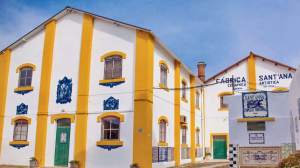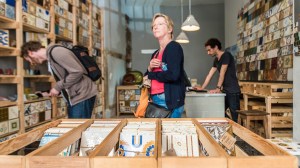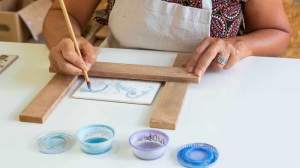Azulejos: the history of Portuguese tiles and where to buy them in Lisbon

The word azulejo means polished stone in Arabic, referring to the origins of these now considered very Portuguese glazed ceramic tiles. Ceramic tiles started being used in Portugal and Spain in the 13th century, when part of the Iberian Peninsula was still being ruled by the Moors of Northern Africa.
Lisbon is probably the world’s city which has more building façades covered in tiles. As back in the day many of these tiles were blue and white, it’s often assumed that the name azulejo is a derivative of the Portuguese word for blue, azul. When you visit the National Tile Museum in Lisbon (Museu Nacional do Azulejo, R. Me. Deus 4, 1900-312 Lisbon), you can see examples of tiles from the 15th century to the present day, and get acquainted with this ancient tradition that goes beyond decorative purposes and has very practical aspects to its uses too.
Centuries ago, adding tiles to buildings’ facades contributed to preserve the warm temperature inside homes, while these ceramic squares, which are baked at high temperatures, also helped to also delay the flames from spreading in the case of a fire. After the earthquake that destroyed most of downtown Lisbon in 1755, the central area of the city had to be quickly rebuilt. In the 19th century, tiles proved a more inexpensive way than stone or other sturdy materials. Of course, the intricate paintings on tiles we till nowadays see on façades were not strictly necessary to support tiles purposes, but the truth is that over time, colorful tiles came to be an intrinsic part of the country’s aesthetics and popular culture.
Until the 19th century tiles were mostly used inside constructions, and it was around the 1840s that their use to cover buildings and decorate outdoor walls became widespread. During this time, tiles became prevalent not only in buildings of public relevance such as churches and palaces, but also in residential properties where the bourgeoisie would live, thus setting them apart. It was common for the newly rich, like entrepreneurs and families who had been abroad in countries such as Brazil and had returned to Portugal with big fortunes, to decorate their homes with intricate tile panels that would make their buildings and thus their role in society an outstanding one.

In the early 20th century the use of tiles fell into disuse, particularly as these were no longer associated with the ornamental choices of the elite. Regardless of their links with status in society, it’s indisputable how much tiles have contributed to Lisbon’s stylistic feature, as well as to the characteristic warm light that the city is famous for, which is often attributed to the reflections that these ceramic panels help create.
It was around the 1950s that Portuguese tiles entered a new era of appreciation when Lisbon’s metro system came up and some of the stations were decorated using colorful patterns of tiles, mostly by the artist Maria Keil.
When you see azulejos in Lisbon nowadays, they will be a mix of ancient tiles as well as more contemporary creations, both used to give personality to public areas like parks and churches, or beautify building façades, as well as to decorate the inner parts of buildings, as whole mosaic walls or simply as framed murals that stand out like paintings. Visit our Instagram to find some of our favorite places to spot azulejos in Lisbon.
Best stores to buy classical and contemporary Portuguese tiles in Lisbon
Fábrica de Sant’Anna
Opened since 1741 in the neighborhood of Lapa, Fábrica de Sant’Anna is one of the oldest and still operating tile factories in Lisbon. When the earthquake of 1755 took place and the demand for tiles shot up during the reconstruction of downtown Lisbon, the business of this mosaic factory exploded. Ever since then they keep manufacturing tiles following the artisanal methods used when Sant’Anna was founded. Get up close to the tile making process during one of their guided tours.
📍Factory: Calçada da Boa-Hora 96, 1300-096 Lisbon
📍Showroom in Baixa-Chiado: Rua do Alecrim, 95, 1200-015 Lisbon
📍Showroom in Ajuda: Calçada da Boa-Hora 94 B, 1300-096 Lisbon

Cortiço e Neto
When you have a tiled wall at home with pieces from former times and a tile cracks and needs a replacement, it can be difficult to find the exact same design. After all, there are thousands of collections with a variety of colors, shapes and reliefs that might have come from just about anywhere in Portugal. Cortiço e Neto has an incredibly large collection of tiles so if you need to find a specific design, your chances are higher around here. Their catalog covers fairly common contemporary tiles, as well as rarer older ones.
📍Rua Maria Andrade 37D, 1170-215 Lisbon

XVIII – Azulejo & Faiança
18th century inspired tiles and pottery are XVIII’s speciality. Even though this store is located in the heart of the touristic neighborhood of Alfama, its tiles are not to be mistaken with those of surrounding souvenirs shops. If you’d like to own a classical looking tile but may not be ready to pay for an actual antique, here you can purchase designs inspired by former tile trends, which you can sometimes even have a glance at how they are being made in store.
📍Largo Santa Luzia nº9, 1100-411 Lisbon

Solar Antiques
This is no more no less than the world’s largest store dedicated to original tiles. If you are an antiques lover looking to add something Portuguese to your collection, at Solar Antiques you can find a vast variety of tiles from between the 15th and the 19th centuries. As you can imagine, here you’ll find old pieces for several thousands of euros, but you can also purchase single tiles for as little as 10 euros. This family run shop is managed by Verónica Leitão, a third generation tile dealer, who believes that more than business Solar Antiques’ goal is to help preserve the culture of azulejos so that future generations can still enjoy this typically Portuguese tradition.
📍Rua Dom Pedro V 70, 1250-094 Lisbon

Surrealejos
Even though it opened its doors in one of Lisbon’s most typical neighborhoods, Castelo, Surrealejos is indeed quite surreal and not at all traditional. This is a project by the Italian designer Luca Colapietro, who thought the world of Portuguese ceramic tiles could use a touch of surrealism. His aesthetic reinterpretations of azulejos translate into tiles with colorful animals, skulls and contemporary looking patterns that remind us of what things look like when we see the world through a kaleidoscope. At Surrealejos you can shop for tiles, of course, but also other merchandise like tshirts, framed panels, and do it yourself kits to build your own tiled walls at home.
📍Rua Pres. Arriaga 100, 1200-774 Lisbon

Where not to buy azulejos in Lisbon
In the stores mentioned above you will find newly made ceramic tiles but also antique azulejos that have been preserved and restored. The latter, that may in some cases even be several hundred years old, have a clear place of origin. But, when you find vintage azulejos in street markets, such as Feira da Ladra (Tuesdays and Saturdys at Campo de Santa Clara, 1100-472 Lisboa), it’s important to question where these antiques may be coming from.
Walking around Lisbon you will easily notice how some building façades are missing squares of azulejos, which one would naturally assume it’s a mark of time passing by. If it’s true that age does damage to the tiled façades, it’s also sadly true that some people are in the business of removing some of these ancient tiles in order to sell them second hand with the pretext of authenticity. As such, it’s very important to always question the origin of the tiles that you may be interested in, particularly when at an unofficial store, once they may be the result of vandalism and theft.
These old tiles are considered so valuable that the Portuguese police force has an entire department dedicated to stolen azulejos, and that goes by the name SOS Azulejos. Since implemented in 2017, SOS Azulejos has helped to drastically decrease the transaction of stolen antique tiles in the black market, but lifted tiles are still very much a presence in Lisbon’s flea markets.
When you buy old azulejos please inquire about their origin and make sure you purchase one of the most stunning souvenirs you can actually get in Lisbon in a responsible and sustainable way.

Portuguese ceramic tile workshops
If after immersing yourself in the world of azulejos you’re curious to learn more about how these Portuguese ceramic tiles are made and preserved, you can visit workshops such as Tardoz or you can even try to make them yourself.
In Lisbon there are several workshops that offer experiences for people who might not have even tried anything related to ceramic or painting before. These are just a few:
🎨 Facade tiles workshop by family studio Cerâmica S. Vicente
https://ceramica-svicentelisboa.com/en/workshops
🎨 Tiles painting workshop by A Casa do Azulejo
https://acasadoazulejo.pt/courses-workshops
🎨 Tile workshop at A Loja dos Descobrimentos
www.loja-descobrimentos.com/work-shop
🎨 The art of azulejos, an Airbnb Experience hosted by Englantine & Caroline
https://www.airbnb.com/experiences/72232
🎨 Instant expert in tiles manufactoring

When you visit Lisbon, you will probably not resist the temptation of taking your photo in front of a tiled wall. Share your best clicks with us via Instagram, tagging @tasteoflisboa or #tasteoflisboa – Happy travels!
Feed your curiosity on Portuguese food culture:
Set the table, for Portuguese essentials
Marvila travel guide for food and art lovers
Itinerary for the perfect weekend in Lisbon
Real people, real food. Come with us to where the locals go.
Signup for our natively curated food & cultural experiences.
Follow us for more at Instagram, Twitter e Youtube
